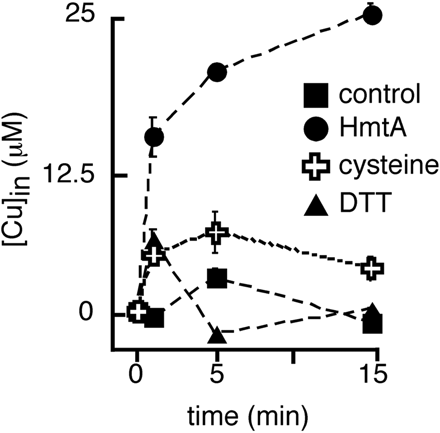Team:Groningen/Project/Transport
From 2009.igem.org
Svenjurgens (Talk | contribs) |
|||
| Line 12: | Line 12: | ||
*Copper /zinc uptake via HmtA | *Copper /zinc uptake via HmtA | ||
| - | *heavy metal uptake coupled to citrate via ''ef''CitH | + | *heavy metal uptake coupled to citrate via ''ef''CitH ''bs''CitM |
*Arsenite uptake via GlpF | *Arsenite uptake via GlpF | ||
*Periplasmic accumulation of heavy metals via Mer Operon. | *Periplasmic accumulation of heavy metals via Mer Operon. | ||
| Line 58: | Line 58: | ||
Lewinson O., Lee A.T., Rees D.C. 2009. A P-type ATPase importer that discriminates between essential and toxic transition metals. PNAS. vol. 106, no. 12, p. 4677-4682. | Lewinson O., Lee A.T., Rees D.C. 2009. A P-type ATPase importer that discriminates between essential and toxic transition metals. PNAS. vol. 106, no. 12, p. 4677-4682. | ||
| - | == | + | ==Citrate coupled uptake== |
| + | Citrate uptake coupled to heavy metals enables forcefeeding of the toxic compounds into the cell when citrate is the only carbound source available. This could be a very effecient strategy to accumelate vass ammounts of heavy metals. | ||
| + | The current candidates are CitM from ''Bacilus subtilis'' and CitH form ''Enterococcus faecalis'' | ||
| + | |||
| + | ===Missing information/To Do=== | ||
| + | *Expression assesment | ||
| + | **Stability | ||
| + | **Level | ||
| + | *Functional assesment | ||
| + | **Uptake speed | ||
| + | **Affinity | ||
| + | **Electrolyte potential generating force | ||
| + | *Eliminate BioBrick restriction sites | ||
| - | |||
===Literature=== | ===Literature=== | ||
| - | + | Blancato, V.S., Magni, C. & Lolkema, J.S. Functional characterization and Me<sup>2+</sup> ion specificity of a Ca<sup>2+</sup>–citrate transporter from <i>Enterococcus faecalis</i>. FEBS Journal 273, 5121-5130(2006). | |
| - | + | Bastiaan krom Citrate transporters of Bacilus subtilis Proefschrift. | |
| - | + | Jessica B. Warner Regulation and expression of the metal citrate transporter CitM Proefschrift. | |
==GlpF== | ==GlpF== | ||
| - | ===Missing information=== | + | ===Missing information/To Do=== |
| + | *Expression assesment | ||
| + | **Stability | ||
| + | **Level | ||
| + | *Functional assesment | ||
| + | **Uptake speed | ||
| + | **Affinity | ||
| + | **Electrolyte potential generating force | ||
| + | *Eliminate BioBrick restriction sites | ||
| + | |||
===Literature=== | ===Literature=== | ||
1. Meng, Y., Liu, Z. & Rosen, B.P. As(III) and Sb(III) Uptake by GlpF and Efflux by ArsB in Escherichia coli. J. Biol. Chem. 279, 18334-18341(2004). | 1. Meng, Y., Liu, Z. & Rosen, B.P. As(III) and Sb(III) Uptake by GlpF and Efflux by ArsB in Escherichia coli. J. Biol. Chem. 279, 18334-18341(2004). | ||
Revision as of 14:32, 7 June 2009
[http://2009.igem.org/Team:Groningen http://2009.igem.org/wiki/images/f/f1/Igemhomelogo.png]
|
|---|
Introduction
We are trying to find suitable systems capable of isolating heavy metals from the environment. There are several different mechanisms to achieve such a thing. We examined 3 kinds:
- Metal transporters, that transport the metal from the environment (ie. wastewater) to the cytoplasm
- Uncoupled
- Coupled with 'helper' protein
- Metal binding proteins in the periplasm
We will investigate severals systems, to find which are suitable for the final design. the following systems are under concideration.
- Copper /zinc uptake via HmtA
- heavy metal uptake coupled to citrate via efCitH bsCitM
- Arsenite uptake via GlpF
- Periplasmic accumulation of heavy metals via Mer Operon.
HmtA

HmtA, heavy metal transporter A from Pseudomonas aeruginosa Q9I147 is a P-type ATPase importer. It mediates the uptake of Copper (Cu) and Zinc (Zn) and is functionally expressed in E.coli.
>gi|81857196|sp|Q9I147|Q9I147_PSEAE Probable cation-transporting P-type ATPase
| Enzyme | Number of Sites |
|---|---|
| EcoRI | 0 |
| XbaI | 0 |
| NotI | 0 |
| SpeI | 0 |
| PstI | 2 |
Missing information/To do
- Expression assesment
- Stability
- Level
- Functional assesment
- Uptake speed
- Affinity
- Electrolyte potential generating force
- Eliminate BioBrick restriction sites
Literature
Lewinson O., Lee A.T., Rees D.C. 2009. A P-type ATPase importer that discriminates between essential and toxic transition metals. PNAS. vol. 106, no. 12, p. 4677-4682.
Citrate coupled uptake
Citrate uptake coupled to heavy metals enables forcefeeding of the toxic compounds into the cell when citrate is the only carbound source available. This could be a very effecient strategy to accumelate vass ammounts of heavy metals. The current candidates are CitM from Bacilus subtilis and CitH form Enterococcus faecalis
Missing information/To Do
- Expression assesment
- Stability
- Level
- Functional assesment
- Uptake speed
- Affinity
- Electrolyte potential generating force
- Eliminate BioBrick restriction sites
Literature
Blancato, V.S., Magni, C. & Lolkema, J.S. Functional characterization and Me2+ ion specificity of a Ca2+–citrate transporter from Enterococcus faecalis. FEBS Journal 273, 5121-5130(2006). Bastiaan krom Citrate transporters of Bacilus subtilis Proefschrift. Jessica B. Warner Regulation and expression of the metal citrate transporter CitM Proefschrift.
GlpF
Missing information/To Do
- Expression assesment
- Stability
- Level
- Functional assesment
- Uptake speed
- Affinity
- Electrolyte potential generating force
- Eliminate BioBrick restriction sites
 "
"